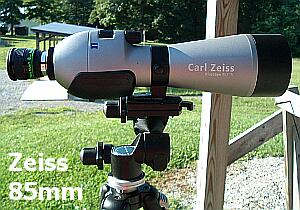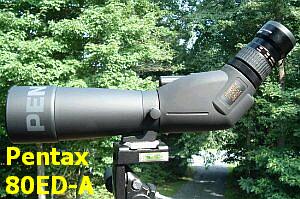Spotting Scopes: Straight vs. Angled
We’ve looked through many different types of spotting scopes. Initially we thought angled was the only way to go. This lets a shooter mount the spotting scope at his side and easily glance through the lens with the scope body rotated 90°. However, at matches where you spot for a partner, the straight scopes seem to work better. You don’t have to bend your neck down or remove your hat and your “free” eye can scan downrange for wind changes. When spotting for your partner (while seated or standing), a tripod-mounted straight scope was definitely the most “user-friendly” set-up.
Straight (in-line) Spotting Scope

Danny Reever, author of our Spotting Scope Review, tell us: “Straight vs. angled? Man, that’s a tough call! Having used both personally for over a year I’d have to say this: I feel the straight gives you a clearer, sharper image. One less mirror to contend with. If you have a dealer that can give you a side-by-side look at a couple of hundred yards the difference is apparent. That’s one reason Chip Allen chose the straight Zeiss over the angled. On the other hand the angled gives you more options in the way of setup which can be a bonus between cramped benches, when you’re spotting for yourself. I don’t shoot prone, but I think the angled would be the way to go for a solo prone shooter, again more setup options. Another benefit of the angled is that you can keep the tripod lower, a plus on a windy day. The 100MM scopes like the Pentax and Optolyth do not offer an angled body option–maybe there are some engineering issues, or perhaps that’s just to control costs.”
Angled Spotting Scope



















When properly setup, another advantage to using a straight scope is it becomes a blinder for the non-shooting eye.
Rick Curtis
Phoenix Az.